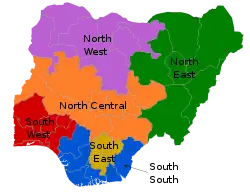South South
The South South (often hyphenated to the South-South) is one of the six geopolitical zones of Nigeria representing both a geographic and political region of the country's eastern coast. It comprises six states – Akwa Ibom, Bayelsa, Cross River, Delta, Edo, and Rivers.
South South | |
|---|---|
| Country | |
| States | |
| Largest city | Port Harcourt |
| Major cities | |
| Time zone | UTC+1 (WAT) |
| Major languages | |

The zone stretches along the Atlantic seaboard from the Bight of Benin coast in the west to the Bight of Bonny coast in the east. It encloses much of the Niger Delta, which is instrumental in the environment and economic development of the region. Geographically, the zone is divided with the Central African mangroves in the coastal far south while the major inland ecoregions are–from east to west–the Cross–Sanaga–Bioko coastal forests, Cross–Niger transition forests, Niger Delta swamp forests, and Nigerian lowland forests.
Although the South South represents only ~5% of Nigerian territory, it contributes greatly to the Nigerian economy due to extensive oil and natural gas reserves. The region has a population of about 26 million people, around 12% of the total population of the country. Port Harcourt and Benin City are the most populous cities in the South South as well as the fourth and fifth most populous cities in Nigeria. Port Harcourt and its suburbs, together called Greater Port Harcourt, form the largest metropolitan area in the zone with about 3 million people; other large South-South cities include (in order by population) Warri/Uvwie, Calabar, Uyo, Ikot Ekpene, Ugep, Sapele, Buguma, Uromi, Ughelli, Ikom, and Asaba.[1]
History
The South South Region was created from both the Western and Eastern regions of Nigeria in 1997 through the recommendation of Alex Ekwueme panel , by the regime of General Sani Abacha. Edo, Delta, one quarter of Bayelsa and the Ndoni section of Rivers states from the old Western region, while three quarter of Bayelsa, Rivers, Akwa Ibom and Cross river states were from the old Eastern region.
Languages
There are multiple different tribes in this area such as Ika, itshekiri Ukwuani Aniocha, Ijaw, Urhobo, Isoko, Ozanogogo, and Abavo.
References
- "Population of Cities in Nigeria (2022)". World Population Review. Retrieved 11 May 2022.